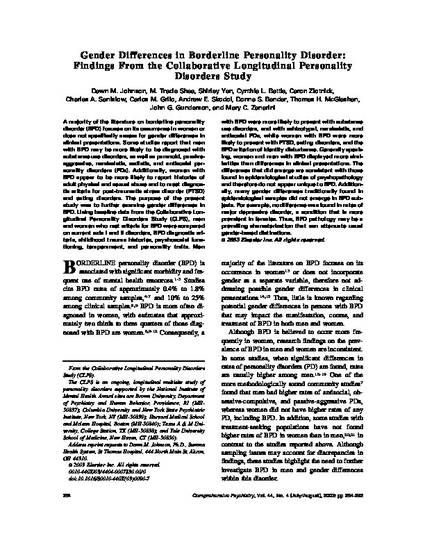
A majority of the literature on borderline personality disorder (BPD) focuses on its occurrence in women or does not specifically assess for gender differences in clinical presentations. Some studies report that men with BPD may be more likely to be diagnosed with substance use disorders, as well as paranoid, passive-aggressive, narcissistic, sadistic, and antisocial personality disorders (PDs). Additionally, women with BPD appear to be more likely to report histories of adult physical and sexual abuse and to meet diagnostic criteria for post-traumatic stress disorder (PTSD) and eating disorders. The purpose of the present study was to further examine gender differences in BPD. Using baseline data from the Collaborative Longitudinal Personality Disorders Study (CLPS), men and women who met criteria for BPD were compared on current axis I and II disorders, BPD diagnostic criteria, childhood trauma histories, psychosocial functioning, temperament, and personality traits. Men with BPD were more likely to present with substance use disorders, and with schizotypal, narcissistic, and antisocial PDs, while women with BPD were more likely to present with PTSD, eating disorders, and the BPD criterion of identity disturbance. Generally speaking, women and men with BPD displayed more similarities than differences in clinical presentations. The differences that did emerge are consistent with those found in epidemiological studies of psychopathology and therefore do not appear unique to BPD. Additionally, many gender differences traditionally found in epidemiological samples did not emerge in BPD subjects. For example, no difference was found in rates of major depressive disorder, a condition that is more prevalent in females. Thus, BPD pathology may be a prevailing characterization that can attenuate usual gender-based distinctions.
- CLPS,
- Collaborative Longitudinal Personality Study,
- Gender,
- Gender Differences,
- Sex Differences,
- DSM,
- DSM-IV,
- Axis I,
- Axis II,
- Personality Disorders,
- Borderline,
- Schizotypal,
- Avoidant,
- Obsessive-Compulsive
- Behavioral Disciplines and Activities,
- Behavior and Behavior Mechanisms,
- Biological Psychology,
- Clinical Epidemiology,
- Clinical Psychology,
- Cognitive Psychology,
- Mental Disorders,
- Personality and Social Contexts,
- Psychiatry,
- Psychiatry and Psychology,
- Psychological Phenomena and Processes,
- Psychology and
- Quantitative Psychology
